Following our road trip to Omaha, western Nebraska and St. Louis back in July, we stayed around our home in East Tennessee for about 3 months. Then we got restless and decided to drive north up US I-75 to the area around Lexington Kentucky, stay for a couple of nights and check out some local attractions.
When
Laurie mentioned to her sister Bonnie that we were going on this short
adventure, a quick decision was made for Bonnie and her husband Bill to drive
over from the St. Louis area and join us…
During our drive north up I-75, we encountered a lot of heavy fog… We took lots of fog photos but it turns out that fog is hard to photograph while in motion. The first photo gives you an idea of how thick the fog was and of course, driving along at 70 – 75 miles per hour with limited visibility is a bit nerve wracking…
In the
second photo, as we moved north and the fog thinned out, we spotted a fast
flowing stream of fog coming right across the highway. It was very much like a river and, while I’ve
seen fog come across the coastal ranges of northern California, this bit of
foggy action was quite different.
…and then we were in the clear! There was some color in the fall leafs but for the third week in October, there was more green than usual. It had been warmer and dryer than usual.
Laurie and I had timed our drive so we could arrive at the Kentucky Horse Park at about the same time as Bonnie and Bill. Laurie and I last visited the Kentucky Horse Park ca. 1987…and it sure has changed…expanded since our last visit.
On our
previous visit, Secretariat (1970 – 1989) was still alive and we had a chance
to see this beautiful champion Thoroughbred race horse in person. He not only won the American Triple Crown, he
still holds the fastest time record for all three races. The Kentucky Derby, Preakness Stakes and the
Belmont Stakes. He actually won the
Belmont Stakes by 31 lengths!
Our first stop after buying our tickets and looking around the Vistor’s Center and displays at the Kentucky Horse Park was the International Museum of the Horse. This museum occupies over 60,000 square feet and it is the largest museum in the world that is dedicated to understanding the history of all horses and their impact on civilization.
Among the
first exhibits we viewed were recreated scenes of early ancestors of Equus, which
includes today’s horses, asses and zebras. ‘Dinohippus’ is thought to be the last direct ancestor
of today’s members of the Equus family.
It lived in North America from about 13,000,000 to 5,000,000 years
ago. Dinohippus had the ‘stay’
apparatus, a safety feature that helped the horse to stand for long periods of
time with little expenditure of energy… Consequently, it was one of the first
horses that could sleep while standing, a valuable ability when it comes to
evading predators.
A number of early horse drawn conveyances are exhibited in the museum, including this full size reproduction of a 2-horse Egyptian chariot that was found in the tomb of King Tutankhamun. (1320 BCE) Another exhibit featured a heavy and comparatively crude Sumerian Battle Wagon modeled after pictographs from tombs dated back to 2600 – 2450 BCE. Both of these horse drawn war machines were effective in assisting their respective armies in conquering neighboring kingdoms…
I love dioramas! The International Museum of the Horse features many dioramas showing the use and impact of horses through various periods of history. The first diorama shown above depicts Attila’s cavalry attacking the town of Constantia near the Danube River. This event took place in 441 A.D. because the Romans neglected to pay their agreed upon tribute which had heretofore caused Attila to refrain from attacking Roman settlements. FYI, the tribute amounted to over a ton of gold each year…
Among the many other dioramas there was this detailed ‘picture’ of life in the winter here in the USA along the frontier. This is just half of the diorama but it shows horses being used on a small homestead as well as a 6 horse hitch pulling a Conestoga wagon across a crude log bridge.
Other
dioramas included Knights jousting, early frontier horse races, and a very
large city scene. The latter showed horses
pulling farm wagons, carriages, a stagecoach, freight wagons, delivery carts,
and a horse drawn bus as well as a horse drawn trolley.
There was a lot of attention paid to thoroughbred horses and their heritage. The first photograph shows the 3 horses that are considered as the foundation stallions of today’s thoroughbred horses. The horses across the top are the “Byerley Turk”, the “Darley Arabian” and the “Godolphin Arabian”.
All 3
stallions have certain things in common.
They were all Arabian horses that were imported to England where they
were bred with existing English stock.
The 3 horses at the bottom of the first photo are famous descendants of
these 3 foundation stallions. FYI, the
Byerley Turk was captured in the late 1600s by Captain Byerley at the siege of
Buda in Hungary and this stallion was the first of these elite horses to breed
in England.
The Arabian horse originated on the Arabian Peninsula. It has a distinctive head shape and holds its tail high. One of the oldest horse breeds in the world, evidence of horses resembling modern Arabians has been found that dates back 4,500 years. Arabian horses have been used to add speed, refinement, endurance and strong bone structure to other breeds and now Arabian bloodlines are found in almost every modern breed of riding horse.
I like transportation related vehicles include airplanes, trucks, automobiles, ships…and horse drawn conveyances. Among the many horse drawn vehicles I noted was this full size Concord stagecoach and a model Sears, Roebuck delivery wagon.
Other
wheeled vehicles on display were a hearse, a skeleton wagon, (basically a light
frame with light wheels and a seat), a Conestoga wagon and of course, a surrey
with the fringe on top.
The museum pays tribute to the Buffalo Soldiers. They originally were members of the 10th Cavalry Regiment of the US Army, formed in September of 1866 at Fort Leavenworth, Kansas. The nickname was given to the Colored Cavalry by Native American tribes who fought in the Indian Wars. The term “Buffalo Soldiers” caught on and became synonymous with all of the African-American regiments formed in that time period. A little recognized fact is that 23 Buffalo Soldiers received the Medal of Honor during the Indian Wars…
Horse
racing was the most popular sport throughout the early history of the United
States. Its popularity was concurrent
with the institution of slavery. It’s a fact
that the care and training of race horses was largely the purview of enslaved
men…
Laurie and I love these gentle giants…the draft horses! The Shire, Percheron, Belgian, Clydesdale and the Suffolk Punch are the 5 largest horse breeds in the world. All of these work horses can reach weights of over 2000 pounds. A couple of these breeds are fairly rare. They include the Percheron and the Suffolk Punch. We’re all familiar with the Anheuser-Busch Clydesdales and if you’ve never seen them up close and personal, it should be added to your things to do list!
Back to transportation…by horse of course! There even is a collection of sleighs. The first photo includes at French Carousel Sleigh from 1780. The sleigh next to it is a doctor’s sleigh from 1890. The second photo is of a bob sleigh from 1905. I never thought about it but it is probable that a sleigh or early sled was the first transport vehicle used by man…boughs or branches being towed across the ground with whatever was being transported on top of the branches.
So…enough
about this piece of the International Museum of the Horse. There was much more to be seen at the
Kentucky Horse Park! To be continued...
Just
click on any of the photos to enlarge them.
Thanks
for stopping by for a visit!
Merry Christmas to all!
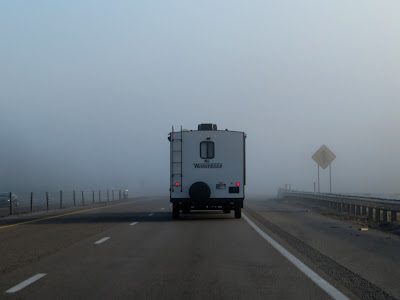





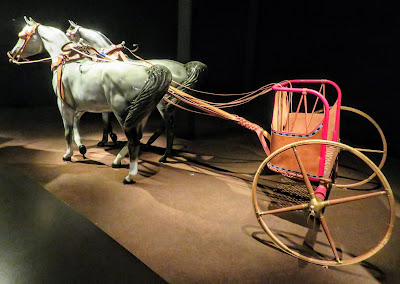



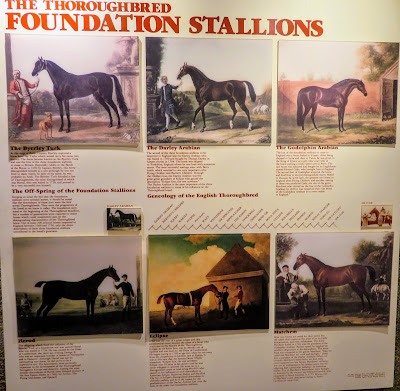


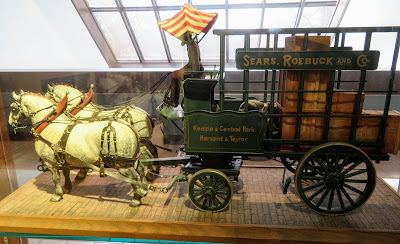



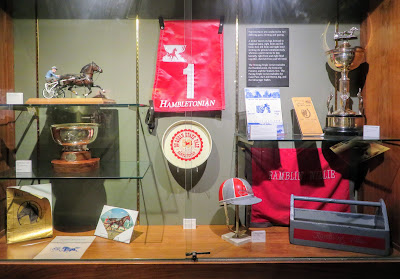


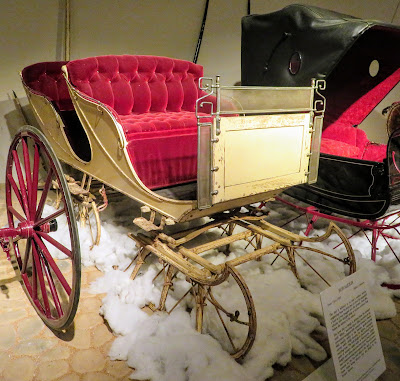
I don't understand much about horses, but they look very handsome. And I have never been to a horse museum. Thanks for the tour, David.
ReplyDeleteGreat tour of the museum. I've stayed the night several times in Lexington, out near I-75 on my way hither and yon. Often think a day touring would be fun!
ReplyDeleteAs you may know, Dave, we always enjoy finding museums on our road trips, and this one would have been on our list (if we were in the area). I agree that dioramas are so interesting and the level of detail in the ones I have seen is truly amazing.
ReplyDeleteNice and lovely trip dear David, I whish for you and Laurie a happy and wonderful Christmas!!!!
ReplyDeleteLooks like an interesting museum.
ReplyDelete